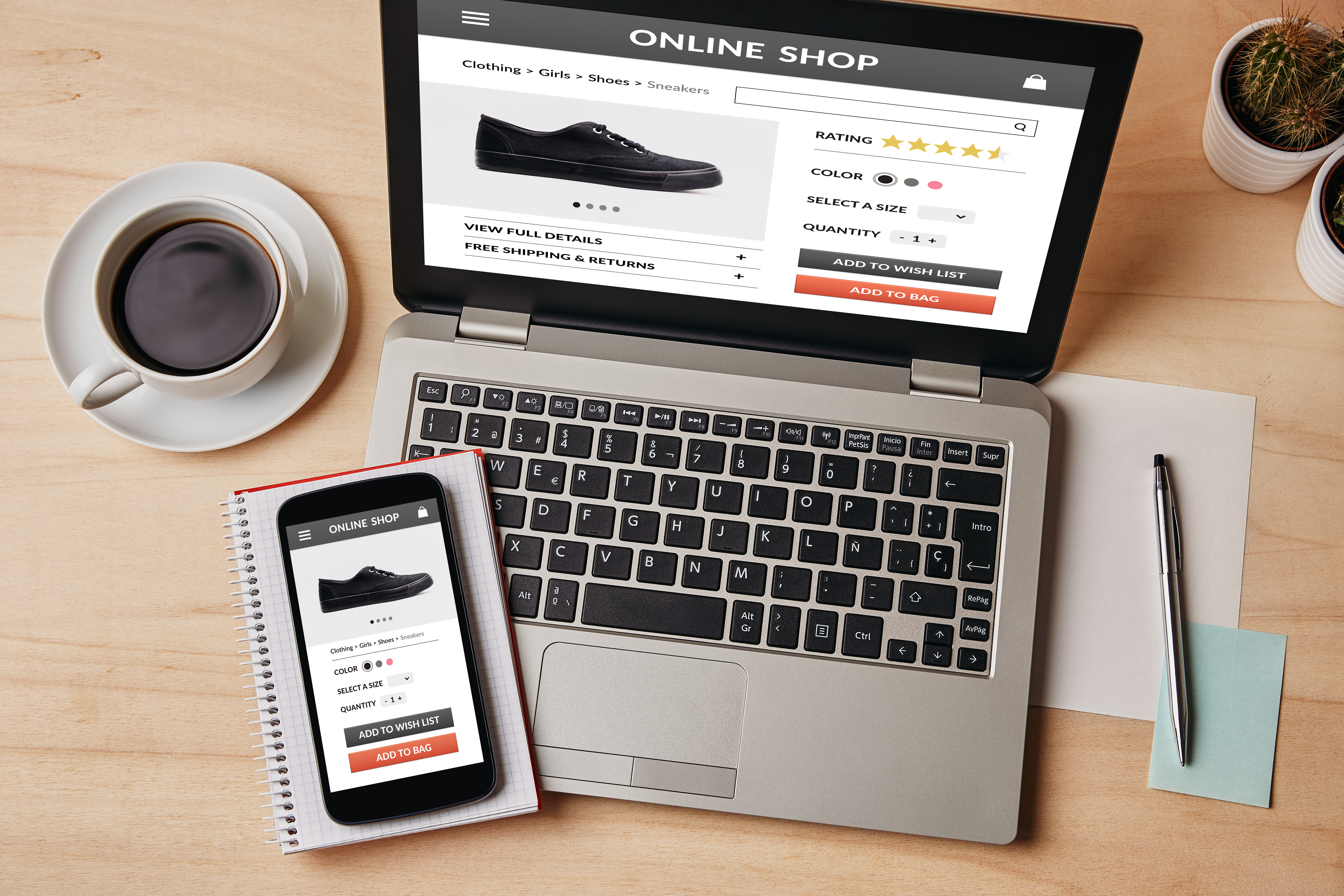November 21, 2022
 by Piyush Shah / November 21, 2022
by Piyush Shah / November 21, 2022

E-commerce marketing helps your business grow, increases sales, and builds brand awareness.
Since most of us are used to shopping online, e-commerce marketing has seen tremendous growth in importance. While some companies struggled with changing consumer behavior, e-commerce organizations that got their marketing right kept growing, attracting more and more business.
After the COVID-19 pandemic began, the share of internet consumers that make purchases online jumped by seven percentage points. For the seven countries that account for half of the world’s gross domestic product (GDP), the value of e-commerce transactions went from $2 trillion in 2019 to $2.9 trillion in 2021.
The e-commerce landscape is constantly changing, and with all the different strategies available, it can be hard to know where to start, but this article is meant to guide you and your company to succeed.
In the upcoming sections, you’ll read about the concept of e-commerce, different types of e-commerce marketing tactics, and bulletproof e-commerce marketing strategies.
E-commerce marketing is a subset of marketing aimed at promoting a business that offers its goods or services online. If you’re trying to sell products online, you cannot afford to ignore e-commerce marketing. Its main objectives are driving traffic to your website, turning visitors into customers, and retaining customers once they purchase.
E-commerce marketing includes a variety of strategies designed to boost revenue and return on investment (ROI) while lowering expenditures on brand promotions. Some are more successful at drawing new customers, while others are more effective at retaining existing customers or prompting sales.
When done right, e-commerce marketing can:
E-commerce marketing encompasses different types of marketing activities. Here are some of the common ones.
Content marketing can aid lead generation, brand building, and customer acquisition for e-commerce websites.
Online businesses can demonstrate value to their clients and respond to customer requirements through customized online experiences using written articles, visual information, and video content. The objective is to engage people and establish trust, so they return and make subsequent purchases.
Numerous ways of creating content are available to you.
Speaking of taking your marketing game beyond your website, no e-commerce store should overlook the potential of social media. Social media sites like Instagram and Twitter are being used effectively by savvy e-commerce marketers to promote their goods, collect client feedback, and conduct in-app sales.
Your ability to use compelling content to attract people to your online store determines your social media success. To master SMM, you must create unique content and marketing campaigns for each network you use to promote your brand. Mix your posting frequency, content, and formats to make the most of each social network.
You can take your social media strategy to a higher level by making shoppable content or material that allows users to make immediate or direct purchases. This ranges from adding tags that link visitors to a checkout page to displaying advertisements placed deliberately within a social media feed. With the help of these techniques, you can easily remove any kind of friction from the purchasing process.
Another excellent SMM technique is user-generated content (UGC) that provides social proof. Potential customers are more inclined to purchase when they notice that others are doing it frequently.
Therefore, pictures of people with your products in real life are among the most potent forms of UGC. This type of unfiltered, genuine content nurtures customer loyalty and piques the curiosity of potential customers.
Search engine marketing (SEM) is a technique to get visitors to a website from search engines like Google and Bing, either organically or through paid advertising. SEM is essential for e-commerce marketing as it describes the steps you need to take to optimize your website or paid ads so that they rank on the search engine results page (SERP).
Your aim should be to rank in the top five search results for the keywords important to your business. According to multiple statistics, most people click on one of the first five advertisements or organic results on SERPs.
There are two basic types of search marketing.
Search engine optimization maximizes organic website traffic via search engines. The overall content quality, relevant keywords, and backlink quantity are just a few variables determining which websites rank high in organic search results.
You’ll have to put in some initial time and work to improve SEO, but once your website starts to rank highly, the traffic you receive is completely free.
You can rely on something other than SEO to rank highly; you can buy your position at the top of search results with paid advertising. However, things become more challenging when several marketers are vying for the topmost ad spaces.
The most extensively utilized PSA platform is Google Ads. The most popular PSA model is Pay Per Click (PPC), which means that you only pay when somebody clicks on your ad. Using Google Ads is crucial to displaying your targeted ads on any of the millions of websites part of the Google ad network.
Email marketing for ecommerce is a terrific strategy to increase sales for your online store. Email campaigns, from complex and customized campaigns to abandoned cart emails, are highly effective in fostering customer relationships.
You should use email marketing because:
The first step in email marketing is building an email list. You can incorporate pop-ups and email sign-up buttons on your website to entice visitors to subscribe to your emails. Offer a deal like free delivery or 15% off your first purchase to attract more sign-ups.
The next step is to send personalized email campaigns to engage your audience with your business. Send a variety of emails to your subscribers to encourage conversion, including:
Utilizing a group of individuals or businesses with a sizable social media following to promote your brand or products is known as influencer marketing. This can involve a famous person, a popular Instagram account, or a group your intended audience follows.
Many e-commerce businesses have found this strategy beneficial by collaborating with social media influencers with sizable followings on Facebook, Instagram, YouTube, and Twitter. Influencers create networks of followers who like, admire, and trust them. This makes it simple for them to generate interest in your products through a referral or a paid post.
You can use influencer marketing platforms to find the right influencers for your business. These platforms let you look for suitable influencers that meet the requirements of your campaign by using filters for pricing, region, and engagement rate. They also help maintain a record of the influencers you've already collaborated with and monitor the development of your campaign.
You can look for micro-influencers by searching for hashtags associated with your brand and keeping an eye on the interaction their posts garner on social media. Reach out to those who appear to have the most sway over their followers and ask them to promote your brand and your products in exchange for money or other rewards.
Despite having a smaller following than macro-influencers, micro-influencers nevertheless manage to have more committed followers than those who don't have an influencer status.
Now that you are familiar with the basics of e-commerce marketing let's bring everything together and go through some tips for planning a solid marketing strategy for your e-commerce store.
Many people are curious about marketing strategies but need help developing a comprehensive plan. This is a huge challenge, as your methods can only provide results over the long term if you have a plan in place.
Before developing a marketing strategy plan, you must codify your goals and performance objectives. Think about what you want to achieve with e-commerce marketing. Some goals could involve:
After you've established a broad one-year goal, refine your objectives. For instance, if gaining new customers is your objective, quantify how many you intend to convert per month.
Understanding your audience's needs and wants helps you communicate with them. It also assists you in producing content people like and share. Consider the following characteristics when you investigate your target market:
You can gain greater insight into your target audience by developing a buyer persona. Begin by gathering their information via interviews, surveys, reviews, and discussion groups.
Sending a questionnaire survey is the ideal method to begin if you already have an established audience. If you still need an audience, start by thinking about whom you want your ideal customer to be.
The next step is to research and understand your competitors in great detail. What are their strengths and weaknesses, the latest industry trends they follow, and how would you compare them to your business? You must know your major competitors, understand their positioning, and decide how to set your company apart.
Find out their e-commerce strategy. Investigate their websites and the products they offer. How comprehensively do they describe their products? Do they use a blog to reach their customers? If so, how frequently do they post? You can also examine your competitors' traffic and determine its sources by registering for an SEO tool like Ahrefs.
Competitor analysis is a continuous activity, so keep an eye on what they're up to and stay ahead of them.
After creating a buyer persona, it becomes simpler to identify your products' most effective marketing channels, draw in buyers, engage with them, boost conversions, and create a marketing strategy to foster loyalty.
Source: NotifyVisitors
Emails and social networking sites like Facebook and Instagram are among the most popular channels, but you may also launch more conventional marketing strategies on television, billboards, or magazines.
Tracking the ROI is the only method to determine if an e-commerce marketing plan is effective. Employ the effective ones for a wider audience, then repeat with the remaining ones.
Four key metrics tell you how close you are to achieving your goals:
Here are some tried-and-tested ideas to up your e-commerce marketing game.
When a lead shows interest in a specific product, you can upsell them by suggesting extras or a higher-priced line of products. Say you go into an Apple Store and inquire about an iPhone 12. Their staff undoubtedly tries to persuade you to invest additional money in an iPhone 12 Pro. Here are some you can upsell your customers
You may have seen that most e-commerce websites like Amazon and eBay provide product recommendations. Customers are shown similar items based on their searches. They’re generally labeled as "Product Suggestions" or "Customers also looked for," and the intention behind them is to persuade the customer to buy more products.
Source: Amazon
You've persuaded your potential customers to make the initial purchase, so why not share a special offer to encourage them to spend a bit more?
Combining an upsell offer with the stuff your clients are interested in buying helps them make bigger purchases. It's because customers are satisfied and already have faith in your brand. A special offer improves your chances of increasing sales as well.
For instance, if their cart amount is $60 and the customers can save an additional 20% by switching to a larger product, they’ll be more likely to spend a little bit for that discount.
Free shipping tops the list of benefits that buyers say they want. When customers reach the checkout page, they’re prepared to make a purchase, so highlight just how much more they have to put in their cart to receive free delivery.
This serves as a temptation for individuals to consider products at particular price points to satisfy the requirement – these items might not even be the ones the customers were shopping for in the first place.
Remarketing targets people who have already browsed your website with advertisements. In other words, it enables your business to "follow" customers online by displaying highly personalized ads on the websites or social media platforms they frequent the most.
Source: Blue Corono
Remarketing, sometimes referred to as retargeting, has three major advantages for your company and your potential customers:
Striving to personalize your communication produces greater results, regardless of the type of marketing campaign you're working on. The goal of personalized services and content is to boost customer retention, revenue, and customer loyalty.
A smart personalization engine uses artificial intelligence to provide customized offers, 1:1 product suggestions, purchase forecasts, and quick delivery times. E-commerce marketers raise the probability of a sale and improve revenue by reaching customers with the appropriate content at the right moment.
With the help of performance data, you can provide visitors personalized experiences based on their prior behaviors and interests. E-commerce teams should target audiences, personalize content, and analyze e-commerce data to enhance tactics over time by adopting a data-driven marketing approach.
To grow revenue from your most devoted customers, concentrate on customer retention. Here are a few quick, low-cost ideas to reward repeat customers and earn their loyalty.
Give your customers huge discounts when they achieve a certain spending threshold; for instance, offer 10% off their subsequent purchase if they buy something over $100. Limited-time promotions might promote quick transactions, but make sure you are clear about the terms.
It’s about developing a program that rewards devoted customers with incentives to keep purchasing from you. Making a loyalty program for customers requires some thought and effort, but the results are worth it in terms of referrals, retention, UGC, and repeat purchases.
An e-commerce business should consider a few factors when developing a loyalty program. When designing a loyalty program for your e-commerce business, one factor to consider is how your customers can demonstrate their loyalty through social media mentions, repeat business, or content sharing. You also have to decide how you want to reward them. Discounts or unique gifts are two great options.
Giving devoted customers something special is one way to thank them for their support. You can give them access to a brand-new product or service that has yet to be publicly introduced. For instance, consumers can participate in a product's beta release from many tech businesses, including Google. Think of a similar initiative to make your loyal customers feel appreciated.
When users encounter an issue with a product, service, website, or app, they want to save time waiting for a solution. The more time they waste standing by for you, the more probable they will just abandon your website and go somewhere for what they're looking for.
You can engage with your visitors with live chat platforms. For instance, try creating a message that appears on product pages and invites customers to subscribe to your email list in exchange for a discount on the product they're seeing.
Your website serves as the hub of your e-commerce marketing plan, so make an effort to construct a stunning design that wins over visitors right away. A key element of your website's design is its navigation.
Customers are more likely to abandon your website if they can't find the items they're looking for. Your design must be straightforward, organized, and navigable to make it easy for your audience to find products more quickly.
Both your customers and search engines depend on your website being mobile-friendly. Google considers how mobile-friendly your site is with its mobile-first index. Therefore, incorporate responsive design to ensure your website is as on the phone as on a computer.
Responsive design adjusts your website to any device the visitors use to ensure they have the best possible experience.
Creating your own branded and personalized packaging is a fantastic approach to establishing brand recognition and improving customer retention. Even though you probably won't have much face-to-face interaction with your customers if you run an online store, the unwrapping process is a terrific way to get them more involved with your brand and its offerings. They might even post an unboxing video on YouTube!
Appealing packaging is also far more likely to be shared on social media, which increases the possibility that your business will receive greater exposure and recognition. When done imaginatively, personalized packaging makes a lasting impression on your customers. This is crucial for online sellers.
The e-commerce industry will flourish and expand further as we become more interconnected. Online businesses and service providers can use a variety of e-commerce channels, strategies, and techniques to increase website traffic and conversion rates and attract a devoted customer base.
E-commerce marketing is a win-win scenario. You’ll be in front of the curve if you start developing your online business right now.
See how you can build a high-potential e-commerce website and achieve financial success.
Piyush Shah is an affiliate marketer and has helped multiple businesses grow from scratch. He's currently working as Head of SEO at Dukaan.
You just got off the phone with a business partner, and they told you SEO is the only form of...
.jpg) by David Freudenberg
by David Freudenberg
Who’s not guilty of scrolling through their feed at 3 AM, finding an irresistible urge to...
 by Manasa Kumar
by Manasa Kumar
Customer experience is the new competitive ground for companies.
 by Jeff Badal
by Jeff Badal
You just got off the phone with a business partner, and they told you SEO is the only form of...
.jpg) by David Freudenberg
by David Freudenberg
Who’s not guilty of scrolling through their feed at 3 AM, finding an irresistible urge to...
 by Manasa Kumar
by Manasa Kumar


